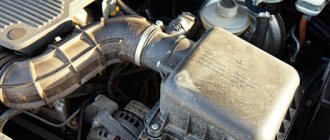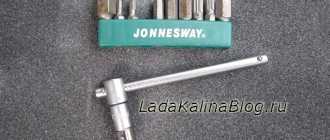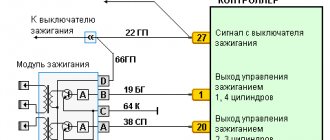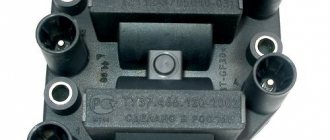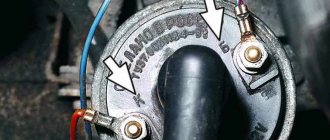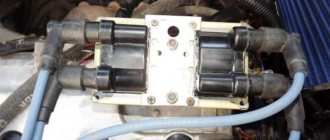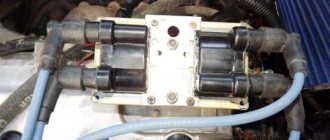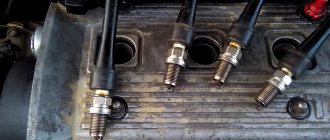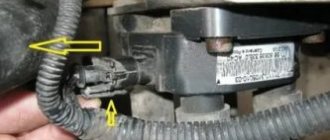Author:
Maxim Markov
The ignition system is one of the most important in any internal combustion engine. Almost all operational characteristics depend on its correct operation. And often the main reason why a car engine does not start is that there is no spark from the ignition coil. To understand why it is such a critical element, you need to understand the operating principle of the entire system as a whole and become familiar with its various types.
What are the types of ignition systems?
Ignition systems that use coils in their operation are divided into two groups: contact and non-contact.
- Contact systems (classic VAZ models). Here, the distribution of the electric current supplied to the spark plugs is carried out using a moving contact (“slider”), which is installed in the distributor housing.
- Contactless systems. High-voltage pulses are also created here, and they are distributed among the cylinders by a special contactless slider and switch. Such systems are installed on carburetor models of front-wheel drive VAZs, as well as Tavria. On engines equipped with an injection system, the spark distribution is handled by the engine control system (all injection VAZ models), and the coils themselves are made either as a single unit (one for each cylinder) or as separate modules (installed directly on the spark plugs).
Characteristic signs
The following phenomena usually indicate poor performance of the ignition system:
- difficulty starting the engine;
- increased fuel consumption;
- unstable idle;
- weak traction and lack of power, failures in engine operation, poor throttle response;
- the appearance of black soot on the candles;
- periodic shutdown of one of the cylinders.
Diagnostics and troubleshooting
It should be remembered that deviations in the normal operation of the engine are almost always caused by only two groups of reasons: malfunctions in the power supply or ignition system. Therefore, you should proceed to diagnosing the ignition operation only after clearly eliminating causes related to the fuel supply.
Troubleshooting should only be done after eliminating all other possible causes. To do this, perform the following steps sequentially:
- Check the presence of plus and minus on the wires going to the ignition coil. If not, then you should understand the reasons why there is no power.
- Check for the presence of a spark at the spark plugs. If there is no spark or it is weak, then the reason may be in the spark plugs themselves, the high-voltage wires, the central wire, the distributor or the coil itself. Spark plugs are checked as follows. To do this, you need to unscrew the spark plug, put a high-voltage wire on it and attach its body to the “ground” (cylinder block), and then crank the engine 1-2 turns with the starter. The presence of a spark indicates the serviceability of both the spark plug, the wire, and the output of the coil or distributor. Attention! Holding a candle with your hand can result in a strong electric shock, so be sure to hold it either with protected pliers or in electrical gloves.
What to do
If the engine runs or starts poorly, motorists are interested in how to strengthen the spark on the spark plugs. First, you need to establish the cause of the breakdown by checking the previously mentioned components and elements using a multimeter and visual inspection. Many faults can be seen by eye.
Often, a simple replacement of spark plugs or glow plugs can help improve the spark (depending on the type of internal combustion engine (petrol or diesel). It is advisable to buy elements from well-known manufacturers in the mid-price category, beware of counterfeits. Faulty spark plugs can often be identified by their appearance. In addition, their replacement is required with the following symptoms:
- Engine tripping.
- Poor starting of the power plant, especially in cold or wet weather.
- White smoke from the exhaust pipe of a car with a diesel engine.
- Reduced vehicle dynamics.
- Increased fuel consumption.
It is worth noting that sometimes similar symptoms are observed when other parts of the car fail. Therefore, if the spark plugs visually look serviceable, it is better to check other components and elements. If you were unable to determine the cause yourself or replacing the SZ did not help, it is recommended to contact a car service for professional diagnostics.
The spark power may not be enough if the ignition coil is broken or the high-voltage wires fail. Therefore, they should be tested with a multimeter. Replacing these parts often helps improve the spark.
Increased power is often achieved by replacing the distributor. Repairing the low voltage circuit or improving the conductivity of the connection contacts often helps solve the problem. To search for an open or short circuit, use a multimeter. Often, replacing or charging the battery with a charger helps increase spark power. Everyone knows that a weak battery does not contribute to good engine starting, especially in winter. Therefore, it must be checked before the cold weather. If it is old or poorly charged, it should be replaced or charged. Recharging may also be required after the machine has been idle for a long time.
But sometimes, in order to completely get rid of the problem, you only need to modify the spark plugs yourself. This is primarily relevant for owners of used domestic cars or old inexpensive foreign cars. This method is also suitable for some budget-conscious motorists. For this modification you need to purchase:
- High voltage copper wires.
- Spark booster.
- Kit for installing contactless ignition (if the car has an old contact system).
- Spark plugs without resistors.
The method consists of several stages. You don't have to do all of them. Perhaps one of the proposed solutions is enough for someone to increase the spark. Refinement is carried out according to the following algorithm:
- Install spark plugs without resistors. This should increase the amount of free energy by about 50%.
Almost all modifications can be done independently with minimal knowledge of car repair and maintenance. But, if such tuning yourself seems difficult, it is better to contact a service station, where the problem with a weak spark will be solved by experienced specialists. True, the costs may increase several times.
Checking the operation of the ignition coil
First of all, you should make sure whether the ignition coil sparks at all. To do this, you need to remove the distributor cap and turn the crankshaft so that the contacts close, and then bring the end of the central wire going to the coil to the ground (engine cylinder block) at a distance of 5-6 mm, and then turn on the ignition.
If it is working properly, a bright spark will be observed. If the spark is weak or not observed at all, the problem is in the coil (or in the central high-voltage wire). In some cases, a situation is possible when, due to poor insulation, sparking of the ignition coil itself is observed, right along its surface.
The next step is to check its low-voltage and high-voltage circuits. To diagnose the primary winding, you need to use an ohmmeter to measure the resistance on the coil between the positive and negative contacts. It should be about 3-5 ohms. To check the secondary winding, the resistance between the positive contact and the central terminal of the coil is measured.
Here the readings should be about 6-7 kOhm. These values are indicative and may vary depending on the specific vehicle model. If the winding is broken, the ohmmeter will show zero; if there is a short circuit, the readings will tend to infinity. In this case, replacement is indicated, since, most likely, its body is leaking. On an injection engine, the coils are measured individually.
Starter does not turn
The most common reason why a VAZ 2106 refuses to start is usually related to the starter of this car. Sometimes the starter categorically refuses to rotate after turning the key in the ignition. This is why:
- The battery has run out. The first thing an experienced V6 owner checks is the condition of the battery. This is very simple to do: you need to turn on the low beam headlights and see if they shine brightly. If the battery is very low, the headlights will shine very dimly or not at all. The solution is obvious: you should remove the battery from the car and charge it using a portable charger;
- one of the terminals is oxidized or poorly screwed. If there is no contact at the battery terminals or this contact is very weak due to oxidation of the contacting surfaces, the starter will not rotate either. In this case, the low beam headlights can shine normally, and all the lights on the instrument panel will light up properly. But there is not enough charge to crank the starter. Solution: after each unscrewing of the terminals, they should be thoroughly cleaned with fine sandpaper, and then a thin layer of lithol should be applied to the contact surfaces. This will protect the terminals from oxidation, and problems with the starter will no longer arise;
- The ignition switch is faulty. The ignition switches in the “sixes” have never been very reliable. If no problems were identified when inspecting the battery, it is likely that the cause of problems with the starter is in the ignition switch. This is easy to check: you should disconnect a couple of wires going to the ignition and short them directly. If after this the starter starts to rotate, then the source of the problem has been found. Ignition switches cannot be repaired. So the only solution is to unscrew a couple of bolts that hold this lock in place and replace it with a new one;
- The solenoid relay is broken. It is not difficult to find out that the problem is in the relay. After turning the ignition key, the starter does not rotate, but the driver hears quiet, but quite distinct clicks in the cabin. The serviceability of the relay is checked as follows: there is a pair of contacts on the starter (those with nuts). These contacts should be closed with a piece of wire. If the starter then begins to rotate, the solenoid relay should be changed, since it is simply impossible to repair this part in a garage;
- The brushes in the starter are worn out. The second option is also possible: the brushes are intact, but the winding on the armature is damaged (usually this occurs due to the short circuit of adjacent turns from which the insulation has fallen off). In both the first and second cases, the starter will not make any sounds or clicks. To determine that the problem is in the brushes or damaged insulation, the starter will have to be removed and disassembled. If the “diagnosis” is confirmed, you will have to go to the nearest auto parts store for a new starter. This device cannot be repaired.
Prevention methods
To extend the life of system elements, you should, firstly, keep them clean. This applies to all components in the engine compartment. The fact is that dirt is a conductor of electricity and part of the high-voltage pulse can be lost through it.
Missing sparks can also be caused by old, oily spark plugs with cracked insulators that have expired. The spark gap should also be set according to the recommendations in the operating instructions. It is necessary to ensure that all high-voltage wires are securely and tightly connected to the terminals and spark plug tips.
conclusions
Identifying the malfunction and the reasons why the ignition coil does not spark depends primarily on its correct and consistent diagnosis. In addition, its long and trouble-free operation largely depends on care and maintenance. Only in this case will the car always delight you with impeccable performance, and its operation will bring only joy.
The operation of the VAZ 2106 power unit is inextricably linked with the formation of a spark, which is influenced by almost all elements of the ignition system. The appearance of malfunctions in the system is reflected in the form of problems with the engine: tripping, jerking, dips, floating speeds, etc. occur. Therefore, at the first symptoms, you need to find and eliminate the cause of the malfunction, which every Zhiguli owner can do with his own hands.
No spark on VAZ 2106
Sparking is an important process that ensures the startup and stable operation of the power unit, for which the ignition system is responsible. The latter can be contact or non-contact, but the essence of its work remains the same - to ensure the formation and distribution of a spark to the desired cylinder at a certain point in time. If this does not happen, the engine may either not start at all or run intermittently. Therefore, it is worth dwelling in more detail on what kind of spark there should be and what the reasons for its absence may be.
Why do you need a spark?
Since the VAZ 2106 and other “classics” are equipped with an internal combustion engine, the operation of which is ensured by the combustion of the fuel-air mixture, a spark is required to ignite the latter. To obtain it, the car is equipped with an ignition system, in which the main elements are spark plugs, high-voltage (HV) wires, a distributor-breaker and an ignition coil. Both spark formation as a whole and the quality of the spark depend on the performance of each of them. The principle of obtaining a spark is quite simple and comes down to the following steps:
- Contacts located in the distributor provide low voltage supply to the primary winding of the high-voltage coil.
- When the contacts open, a high voltage is indicated at the coil output.
- High-voltage voltage is supplied through the central wire to the ignition distributor, through which sparks are distributed to the cylinders.
- A spark plug is installed in the cylinder head for each cylinder, to which voltage is supplied via explosive wires, as a result of which a spark is formed.
- When a spark appears, the combustible mixture ignites, ensuring the operation of the engine.
What should be the spark?
Normal engine operation is possible only with a high-quality spark, which is determined by its color, which should be bright white with a blue tint. If the spark is purple, red or yellow, this indicates problems in the ignition system.
Signs of a bad spark
The spark can be either bad or completely absent. Therefore, you need to figure out what the possible symptoms are and what could be the cause of problems with sparking.
No spark
A complete lack of spark is manifested by the inability to start the engine. There can be many reasons for this phenomenon:
- wet or failed spark plugs;
- damaged explosive wires;
- break in the coil;
- problems with the distributor;
- failure of the Hall sensor or switch (on a car with a contactless distributor).
Video: searching for a spark on a “classic”
Weak spark
The power of the spark also has a significant impact on the functioning of the power unit. If the spark is weak, the combustible mixture may ignite earlier or later than necessary. As a result, power decreases, fuel consumption increases, failures occur in different modes, and the engine may also misfire.
Tripletion is a process in which one of the cylinders of the power plant works intermittently or does not work at all.
One of the reasons why the spark may be weak is the incorrect clearance of the ignition distributor contact group. For classic Zhiguli cars this parameter is 0.35–0.45 mm. A gap less than this value results in a weak spark. A higher value, at which the contacts in the distributor do not completely close, can lead to a complete absence of a spark. In addition to the contact group, other components of the ignition system should not be overlooked.
An insufficiently powerful spark is possible, for example, when spark plug wires break down, i.e., when part of the energy goes to ground. The same thing can happen with a spark plug when the insulator is pierced or a significant layer of soot forms on the electrodes, preventing the breakdown of the spark.
Spark to the wrong cylinder
Quite rarely, but it happens that there is a spark, but it is supplied to the wrong cylinder. At the same time, the engine runs unstable, troits, and shoots into the air filter. In this case, there can be no question of any normal operation of the motor. There may not be many reasons for this behavior:
- the explosive wires on the distributor cap are mixed up;
- the cover on the distributor is installed incorrectly;
- The spark plug wires are not connected correctly to the spark plugs.
The last point, although unlikely, since the length of high-voltage cables is different, is still worth considering if problems with ignition occur. The listed reasons arise, as a rule, due to inexperience. Therefore, when repairing the ignition system, you need to be careful and connect the explosive wires in accordance with the numbering on the distributor cover.
avtoexperts.ru
As you know, for an engine to operate, two conditions are necessary: the presence of fuel and a spark to ignite it. In cases where the spark disappears, starting the power plant becomes impossible.
This applies to a situation where the spark disappears completely, but there may be no spark on individual cylinders, when the engine begins to trip, there is an unstable start, a decrease in dynamics and power against the background of increased fuel consumption.
The situations are different, as are the troubleshooting paths.
9 reasons why there is no spark at all:
Spark plug
The electrodes of the spark plug may become covered with an oil coating, carbon deposits may appear, sometimes completely closing the gap between the electrodes, an insulator breakdown may occur, the electrodes will burn out and the spark plug will fail.
Spark plug electrodes in oil
Ignition coil
There may be an interturn short circuit in the ignition coil or a winding break.
Checking the ignition coil
Distributor distributor
The distributor may have faulty contacts, a Hall sensor, a broken slider, or a crack in the cover.
Distributor
Egnition lock
The contact group in the ignition switch may be faulty (burning of contacts, melting of the plastic protrusion that controls the switching of contacts.
High voltage wires
The problem in the wires can be expressed in their cracking, burning of the internal core and breakdown of the external insulation.
Faulty BB wire
Hall Sensor
In a contactless ignition system, the Hall sensor is responsible for interrupting the spark, failures of which are often caused by the loosening of its mounting bolts, or a breakdown of the sensor itself.
In the photo - hall sensor
Crankshaft sensor
If the DCV fails or there is poor contact in the connection with the sensor, the engine will not start even if there is a spark in the ignition system. It is necessary to check the connection or replace the sensor.
ECU
If there is a failure in the electronic engine control unit, there may also be no spark and it is necessary to carry out computer diagnostics of the unit.
Engine weight
Ground wire – poor contact or broken connecting wire.
Procedure for checking the ignition system
In order to understand in what order it is necessary to start checking the system, let us briefly recall how it works.
Scheme of operation of the classic ignition system
When the key is turned to the “ignition” position, power is supplied through an additional lock relay to one of the terminals of the low-voltage primary winding of the ignition coil. The coil has two low-voltage terminals; from the second terminal, the coil is connected through a wire to the terminal of the distributor.
Then, when the engine starts, a high voltage is created in the secondary winding of the coil, which is supplied through its central high-voltage wire to the central terminal of the distributor cover.
Then the voltage is transmitted through the conductive part of the slider and the built-in resistance to the high-voltage wires to each cylinder, according to the operating diagram of the engine. The wires, in turn, transmit voltage through the tip of the spark plug to the spark plug itself, between the electrodes of which a spark ultimately jumps, igniting the air-fuel mixture.
To ensure that voltage from the coil is not constantly supplied, contacts are installed in the distributor that interrupt and connect the power circuit of the coil, depending on the position of the cams of the distributor shaft. If the contacts burn, the spark may also disappear.
Let's go back to checking the system
If the spark is lost, then you need to find exactly where the circuit broke, starting from the fuses (the circuit is not protected on all models), the ignition switch and then according to the described circuit, step by step checking the serviceability of all its elements.
So, if when you turn the key to the “ignition” position, the warning lights on the instrument panel light up, and there is voltage at the coil terminals, then the lock and the low-voltage circuit are working.
Next, you can check several elements at once. To do this, when cranking with the starter (an assistant is needed), the high-voltage wire is removed from one of the spark plugs, but not completely, but by holding the cap over the spark plug.
If the circuit is working properly, then clear clicks will be heard, otherwise the check must be started from the ignition coil.
Ignition coil
The armored wire from the ignition coil to the central socket of the distributor cover is removed from the cover and touches any metal part of the engine with a small gap. When turning the starter between the wire and the metal part, if the coil is working properly. there should be a spark.
If there is no spark and the high-voltage wire is in good condition, then the coil is faulty and needs to be replaced.
If the coil is working properly, you need to remove the distributor cover and first check the cover itself for cracks, and then the distributor slider.
Distributor slider
You can check the slider in two ways using the same high-voltage wire from the ignition coil or using a device, placing it on the “resistance”.
In the first case, with a contact ignition system, the crankshaft must be turned so that the contacts close, then, with the ignition on, bring the wire from the ignition coil over the slider with a small gap and use a screwdriver to open the contacts.
If the slider is “broken,” then a spark will jump between it and the wire; if not, then the slider is not piercing to ground. Then you need to use a tester to check the integrity of the noise suppression resistor installed in the spacer plate of the runner.
Distributor slider
If the resistor “burns out,” then there will be no circuit and the slider will not be able to transmit voltage to the terminals of the high-voltage wires going to the engine cylinders. The slider needs to be replaced.
To get to the garage, you can remove the resistance from the slider and wrap it, for example, in cigarette foil and put it in place, this will be enough to get to the garage or auto shop. In general, it wouldn’t hurt if the driver had a spare slider in the glove compartment in case it breaks down.
Distributor contact group
If the slider is working properly, it is necessary to inspect the contacts for cleanliness and check whether they open when the distributor shaft is turned. If the contacts are working properly, then you need to check the power wire coming from the ignition coil at its entrance to the distributor.
Often the plastic insert cracks and the voltage goes to ground, thereby breaking the power circuit.
From practice.
There was such a case. The owner of the car, a person with driving experience, plus several neighbors in the garage, could not start the engine, although there was a spark when checking. With the ignition on, he brought the high-voltage wire from the coil to the engine ground and opened the contacts with a screwdriver - an excellent spark jumped out.
When cranking the starter, the engine did not start. Upon detailed inspection, I discovered that the plastic protrusion of the contacts, due to which they opened when they met the cams of the distributor shaft, broke off and the contacts simply did not open.
The contacts were replaced and the engine started with half a turn.
The second is a similar case, but with an ignition switch.
The six VAZs had already been towed for several hundred kilometers on trailers, getting to the house. We then worked outside the city. The next tug unfastened the rope and left, and the owner came to us with a request to sell the ignition coil, since, according to him, it was faulty and therefore there was no spark and the engine would not start.
Upon inspection, the following was found. The bolt on the coil where the low-voltage supply goes was literally torn out. We checked the coil and it is working, despite the loose bolt.
Next, we removed the contact group of the ignition switch, and it turned out to be a similar picture. The plastic protrusion that “commanded” the contacts melted. When the key was turned to the “ignition” position, the lights on the dashboard came on and the circuit was working properly; when the key was turned to the “start” position, the ignition circuit was opened and the starter spun in vain.
We removed the wires from the contact group, connected those responsible for the ignition, and “striking” the wires responsible for the starter, immediately started the engine. The owner was very upset that he paid so much for towing a working car.
No spark in a particular cylinder
Troubleshooting must begin immediately with the spark plug of this cylinder. The spark plug is turned out, its condition is examined, and if it does not outwardly show any signs of malfunction (contacts are burnt out, there is no gap between the contacts, it is not in oil, etc.), then the spark plug is checked for serviceability.
To do this, on carburetor engines, the spark plug body is pressed against the engine block with a high-voltage wire attached and the engine is cranked by the starter. If the spark plug is working properly, that is, it produces a white and blue spark, then the problem should be looked for in the cylinder itself.
Read about how to check spark plugs here
If there is no spark, then the wire of this cylinder is checked with a known good spark plug, and if a spark appears, then the problem is in the spark plug that was previously in the cylinder. A new spark plug is installed and the engine is started, if the cylinder is working, then the problem was in the spark plug, but if not, then you need to check the compression in this cylinder, as well as the clearance in the valves of this cylinder (the valve clearances are pinched) in order to identify the cause of the malfunction.
If there is no spark when checking a known-good spark plug, you need to check the condition of the high-voltage wire, the output to this cylinder in the distributor cover (a crack is possible).
On injection engines, it is not recommended to check spark plugs by contacting them with ground, as the ECU and other electronic systems may fail. To check the spark on injection engines, there are special devices - spark gaps, which are recommended to be used.
Since spark plugs most often fail, we recommend that you always have a spare set so that they can be quickly replaced on the road.
Summary
As we can see, having knowledge about the design and operation of the ignition system, as well as a car tester, will help any car owner identify and find a fault without contacting a car service center.
Checking the contact distributor
The need to check the distributor-breaker arises if problems arise with sparking, but during the diagnostics of the ignition system elements the problem could not be identified.
Cover and rotor
First of all, we inspect the cover and rotor of the device. The check consists of the following steps:
- We dismantle the distributor cover and inspect it inside and out. There should be no cracks, chips, or burnt contacts on it. If damage is found, the part must be replaced.
contact Group
The main malfunctions of the ignition distributor contact group are burnt contacts and incorrect clearance between them. In case of burning, the contacts are cleaned with fine sandpaper. If they are severely damaged, it is better to replace them. As for the gap itself, to check it it is necessary to remove the cover of the distributor-breaker and turn the engine crankshaft so that the cam on the distributor shaft opens the contacts as much as possible. We check the gap with a feeler gauge and if it differs from the norm, then we adjust the contacts by unscrewing the corresponding screws and moving the contact plate.
Capacitor
If a capacitor is installed on the distributor of your “six”, then sometimes the part can fail as a result of a breakdown. The malfunction appears as follows:
- problems starting the engine;
- sudden engine stop while driving.
You can check an element in the following ways:
- Control lamp. Disconnect the wiring coming from the coil and the capacitor wire from the distributor according to the figure. We connect a light bulb to the open circuit and turn on the ignition. If the lamp lights up, it means that the part being tested is broken and requires replacement. If not, then it's OK.
What signs indicate a malfunction of the VAZ car distributor?
1. The engine does not start: - there is no gap or too large a gap between the breaker contacts; -burnt and dirty contacts; - the capacitor has failed; - the noise suppression resistance of the “slider” has burned out; - the distributor cover is “broken”; - the low voltage wire is broken or its terminals are oxidized; -Hall sensor burnt out (non-contact ignition). 2. The engine “shakes” at idle: - the gap between the contacts is not normal; - ignition too early. 3. The engine “jerks” at high speeds: - the gap between the breaker contacts is too large; - the spring of the movable contact of the breaker has weakened; - the springs of the centrifugal regulator have weakened. 4. “Jerking”, interruptions in all engine modes: -damage to high voltage wires, oxidized or loose in the sockets; -dirty, oily, burnt breaker contacts; - the corner of the moving contact in the distributor cover is worn out or broken; -cracks and burnouts of the “runner” and the distributor cover; - the capacitor is “half broken” and needs to be replaced; - the bushings are worn out and the distributor shaft is “playing”; - the contactless ignition system switch is faulty. 5. The car accelerates slowly, consumes a lot of fuel: -the ignition timing is incorrectly set
Note! Signs of a malfunction of the VAZ-2107 distributor are very easily confused with manifestations of malfunctions in the power system. Therefore, never start disassembling the distributor and carburetor with the fuel pump at the same time!
The main reasons why there is no spark
- problem with spark plugs (flooded or faulty);
- breakdown of high-voltage wires or loss of contact;
- the reason is the crankshaft sensor (requires checking with a multimeter);
- malfunction in the ignition module;
- failure of the ignition coil;
- problem in the switch;
- Distributor malfunction (burned contacts, loss of clearance);
- poor ground wire contact;
- failure or malfunction of the ECU;
Differences in testing methods for carburetor and injection internal combustion engines
To determine the malfunction, you need to check all the spark plugs individually. Often, an improvement in the spark occurs when replacing a set of spark plugs. But sometimes the reason may be different. At the same time, all SZs break down at the same time infrequently.
Checking these elements for cars with carburetor and injection engines is different. For the first type of car, it is enough to unscrew the spark plug, connect the wire and touch the ground with the metal part. Turn on the car ignition.
This method is not suitable for vehicles with fuel injection engines. These cars are equipped with many electronic devices. They may fail during such a test. Therefore, it is recommended to use a multimeter to diagnose the condition of the spark plugs. It will allow you to safely and accurately identify a faulty SZ.
No spark injector
It is recommended to use a spark gap to understand at what stage there is no spark on the spark plugs (no spark from the distributor, no spark from the coil, or directly from the spark plug itself). If there is no spark in all cylinders at the same time, there may be several culprits:
- controller;
- entire module;
- coil or center wire.
If there is no spark from the ignition coil, then the reason may be hidden in many places. First of all, you need to check the high voltage wire, which must be in perfect condition and without damage to the insulation. Otherwise, the wire needs to be replaced.
No spark, check spark plugs
If the problem is not solved, then check the spark plugs. The spark plug contacts must be clean. The fact that there is no spark may be caused by dirty spark plug contacts. It is best to replace the spark plugs, but you can also clean the contacts. But before changing the spark plugs, check whether the discharge reaches the spark plugs themselves. To do this, remove the spark plug wire and bring it to the car body at a distance of 0.5 cm. Turn the starter several times and see if there is a spark between the wire and the body. The spark should be white with a slight blue tint. If it is absent or present, but with a different shade, we can say that the spark plugs are fine, and the problem is in the heart of the car’s ignition system – the coil.
Additional recommendations
If the engine begins to run poorly or starts, diagnostics should begin by checking the spark plugs. When disconnecting wires, you should mark them with “+” and “-” signs so as not to be confused when connecting. Even if the SZ visually looks normal, it is better to replace them and drive them for a while. If the problem persists, check the high-voltage wires, ignition coil and other system elements. Self-repair of an ECU without special knowledge and experience is impossible. Unqualified intervention in its device can lead to more significant damage and costs.
Now you know why there may be a weak spark on the candles and how to deal with this scourge with your own hands. Have you ever had problems starting the engine for this reason? Were you able to fix it yourself or did you contact a service station? What exactly helped? If you have any questions or want to share useful advice on the topic, write in the comments.
Malfunctions of the car’s ignition system are unpleasant because any of them is always accompanied by serious interruptions in the engine’s operation or its complete stop. The main sign of a malfunctioning ignition system is the complete absence or “weak” spark between the electrodes of the spark plugs. What to do if there is no spark, and where to look for it? Read about this and more in our material.
Most often, the spark disappears precisely at the moment when you need to go somewhere. In order not to push the car to the nearest car service center, it is important to understand what the operation of the ignition system depends on, then finding the missing spark will not cause any particular difficulties.
At the end of this article, watch the video instructions for finding a spark in the ignition system of VAZ cars.
And below we propose to get acquainted with the algorithm for searching for a missing spark in a car’s ignition system.
How to check spark on ignition coil
To see if the coil is working at all, pull the wire from the breaker distributor that comes from the coil. The same test is carried out with it as with the spark plug wires, namely, they bring the wire to a distance of 0.5 cm and turn the starter. Now, regardless of the result, we can accurately talk about the cause of the breakdown.
In the first case, you need to check the contacts in the distributor-breaker for oxidation, insulation damage, and also check the serviceability of the rotor. If there is no spark due to it, the rotor must be replaced.
Checking the ignition coil
If, after checking, you realize that there is a spark in the car, but it does not start, then the ignition switch may need to be replaced.
